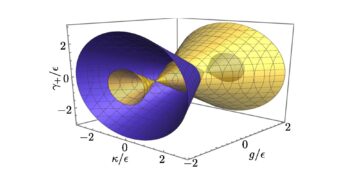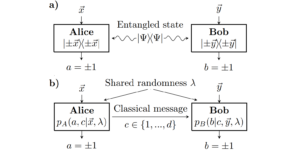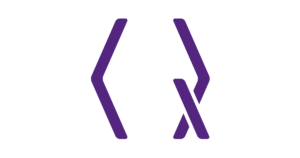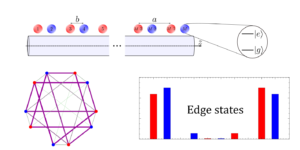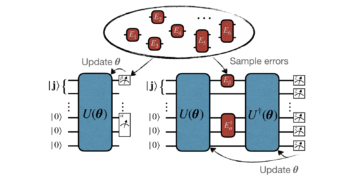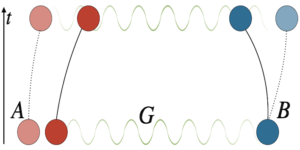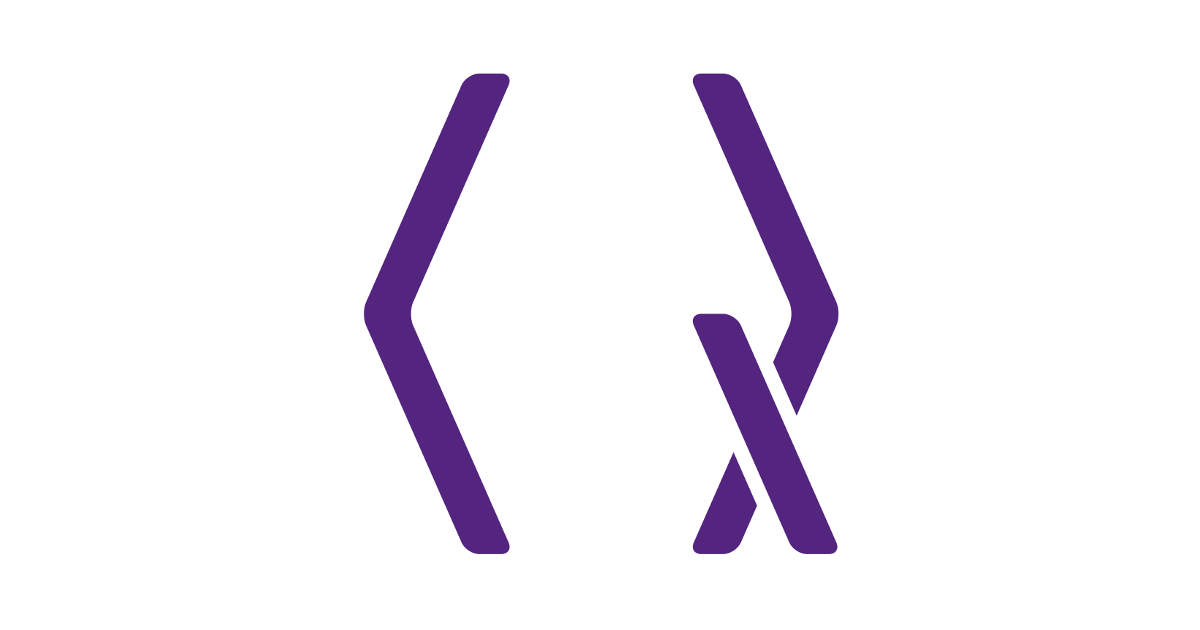
1Department of Physics and Materials Science, University of Luxembourg, L-1511 Luxembourg, G. D. Luxembourg
2Department of Physics Engineering, Faculty of Engineering, Mie University, Mie 514–8507, Japan
3Donostia International Physics Center, E-20018 San Sebastián, Spain
Find this paper interesting or want to discuss? Scite or leave a comment on SciRate.
Abstract
Quantum speed limits (QSLs) provide lower bounds on the minimum time required for a process to unfold by using a distance between quantum states and identifying the speed of evolution or an upper bound to it. We introduce a generalization of QSL to characterize the evolution of a general operator when conjugated by a unitary. The resulting operator QSL (OQSL) admits a geometric interpretation, is shown to be tight, and holds for operator flows induced by arbitrary unitaries, i.e., with time- or parameter-dependent generators. The derived OQSL is applied to the Wegner flow equations in Hamiltonian renormalization group theory and the operator growth quantified by the Krylov complexity.
► BibTeX data
► References
[1] P. Pfeifer and J. Fröhlich, “Generalized time-energy uncertainty relations and bounds on lifetimes of resonances,” Rev. Mod. Phys. 67, 759–779 (1995).
https://doi.org/10.1103/RevModPhys.67.759
[2] P. Busch, “The time–energy uncertainty relation,” in Time in Quantum Mechanics, edited by J. G. Muga, R. S. Mayato, and Í. L. Egusquiza (Springer Berlin Heidelberg, Berlin, Heidelberg, 2008) pp. 73–105.
https://doi.org/10.1007/978-3-540-73473-4_3
[3] L. S. Schulman, “Jump time and passage time: The duration ofs a quantum transition,” in Time in Quantum Mechanics, edited by J. G. Muga, R. Sala Mayato, and Í. L. Egusquiza (Springer Berlin Heidelberg, Berlin, Heidelberg, 2008) pp. 107–128.
https://doi.org/10.1007/978-3-540-73473-4_4
[4] V. V. Dodonov and A. V. Dodonov, “Energy–time and frequency–time uncertainty relations: exact inequalities,” Physica Scripta 90, 074049 (2015).
https://doi.org/10.1088/0031-8949/90/7/074049
[5] L. Mandelstam and I. Tamm, “The uncertainty relation between energy and time in non-relativistic quantum mechanics,” in Selected Papers, edited by Boris M. Bolotovskii, Victor Ya. Frenkel, and Rudolf Peierls (Springer Berlin Heidelberg, Berlin, Heidelberg, 1991) pp. 115–123.
https://doi.org/10.1007/978-3-642-74626-0_8
[6] S. Deffner and S. Campbell, “Quantum speed limits: from heisenberg’s uncertainty principle to optimal quantum control,” Journal of Physics A: Mathematical and Theoretical 50, 453001 (2017).
https://doi.org/10.1088/1751-8121/aa86c6
[7] Z. Gong and R. Hamazaki, “Bounds in nonequilibrium quantum dynamics,” International Journal of Modern Physics B 36, 2230007 (2022).
https://doi.org/10.1142/S0217979222300079
[8] N. Margolus and L. B. Levitin, “The maximum speed of dynamical evolution,” Physica D: Nonlinear Phenomena 120, 188–195 (1998), proceedings of the Fourth Workshop on Physics and Consumption.
https://doi.org/10.1016/S0167-2789(98)00054-2
[9] B. Zieliński and M. Zych, “Generalization of the margolus-levitin bound,” Phys. Rev. A 74, 034301 (2006).
https://doi.org/10.1103/PhysRevA.74.034301
[10] N. Margolus, “The finite-state character of physical dynamics,” arXiv e-prints , arXiv:1109.4994 (2011), arXiv:1109.4994 [quant-ph].
arXiv:1109.4994
[11] A. Uhlmann, “An energy dispersion estimate,” Physics Letters A 161, 329–331 (1992).
https://doi.org/10.1016/0375-9601(92)90555-Z
[12] S. Deffner and E. Lutz, “Energy–time uncertainty relation for driven quantum systems,” Journal of Physics A: Mathematical and Theoretical 46, 335302 (2013a).
https://doi.org/10.1088/1751-8113/46/33/335302
[13] M. Okuyama and M. Ohzeki, “Comment on `energy-time uncertainty relation for driven quantum systems’,” Journal of Physics A: Mathematical and Theoretical 51, 318001 (2018a).
https://doi.org/10.1088/1751-8121/aacb90
[14] M. M. Taddei, B. M. Escher, L. Davidovich, and R. L. de Matos Filho, “Quantum speed limit for physical processes,” Phys. Rev. Lett. 110, 050402 (2013).
https://doi.org/10.1103/PhysRevLett.110.050402
[15] A. del Campo, I. L. Egusquiza, M. B. Plenio, and S. F. Huelga, “Quantum speed limits in open system dynamics,” Phys. Rev. Lett. 110, 050403 (2013).
https://doi.org/10.1103/PhysRevLett.110.050403
[16] S. Deffner and E. Lutz, “Quantum speed limit for non-markovian dynamics,” Phys. Rev. Lett. 111, 010402 (2013b).
https://doi.org/10.1103/PhysRevLett.111.010402
[17] F. Campaioli, F. A. Pollock, and K. Modi, “Tight, robust, and feasible quantum speed limits for open dynamics,” Quantum 3, 168 (2019).
https://doi.org/10.22331/q-2019-08-05-168
[18] L. P. García-Pintos and A. del Campo, “Quantum speed limits under continuous quantum measurements,” New Journal of Physics 21, 033012 (2019).
https://doi.org/10.1088/1367-2630/ab099e
[19] B. Shanahan, A. Chenu, N. Margolus, and A. del Campo, “Quantum speed limits across the quantum-to-classical transition,” Phys. Rev. Lett. 120, 070401 (2018).
https://doi.org/10.1103/PhysRevLett.120.070401
[20] M. Okuyama and M. Ohzeki, “Quantum speed limit is not quantum,” Phys. Rev. Lett. 120, 070402 (2018b).
https://doi.org/10.1103/PhysRevLett.120.070402
[21] N. Shiraishi, K. Funo, and K. Saito, “Speed limit for classical stochastic processes,” Phys. Rev. Lett. 121, 070601 (2018).
https://doi.org/10.1103/PhysRevLett.121.070601
[22] S. B. Nicholson, L. P. García-Pintos, A. del Campo, and J. R. Green, “Time–information uncertainty relations in thermodynamics,” Nature Physics 16, 1211–1215 (2020).
https://doi.org/10.1038/s41567-020-0981-y
[23] V. T. Vo, T. Van Vu, and Y. Hasegawa, “Unified approach to classical speed limit and thermodynamic uncertainty relation,” Phys. Rev. E 102, 062132 (2020).
https://doi.org/10.1103/PhysRevE.102.062132
[24] T. Van Vu and Y. Hasegawa, “Geometrical bounds of the irreversibility in markovian systems,” Phys. Rev. Lett. 126, 010601 (2021).
https://doi.org/10.1103/PhysRevLett.126.010601
[25] L. P. García-Pintos, S. B. Nicholson, J. R. Green, A. del Campo, and A. V. Gorshkov, “Unifying quantum and classical speed limits on observables,” Phys. Rev. X 12, 011038 (2022).
https://doi.org/10.1103/PhysRevX.12.011038
[26] I. Bengtsson and K. Życzkowski, Geometry of Quantum States: An Introduction to Quantum Entanglement, 2nd ed. (Cambridge University Press, 2017).
https://doi.org/10.1017/9781139207010
[27] D. P. Pires, M. Cianciaruso, L. C. Céleri, G. Adesso, and D. O. Soares-Pinto, “Generalized geometric quantum speed limits,” Phys. Rev. X 6, 021031 (2016).
https://doi.org/10.1103/PhysRevX.6.021031
[28] F. Campaioli, F. A. Pollock, F. C. Binder, and K. Modi, “Tightening quantum speed limits for almost all states,” Phys. Rev. Lett. 120, 060409 (2018).
https://doi.org/10.1103/PhysRevLett.120.060409
[29] N. Hörnedal, D. Allan, and O. Sönnerborn, “Extensions of the mandelstam–tamm quantum speed limit to systems in mixed states,” New Journal of Physics 24, 055004 (2022a).
https://doi.org/10.1088/1367-2630/ac688a
[30] M. Bukov, D. Sels, and A. Polkovnikov, “Geometric speed limit of accessible many-body state preparation,” Phys. Rev. X 9, 011034 (2019).
https://doi.org/10.1103/PhysRevX.9.011034
[31] T. Fogarty, S. Deffner, T. Busch, and S. Campbell, “Orthogonality catastrophe as a consequence of the quantum speed limit,” Phys. Rev. Lett. 124, 110601 (2020).
https://doi.org/10.1103/PhysRevLett.124.110601
[32] K. Suzuki and K. Takahashi, “Performance evaluation of adiabatic quantum computation via quantum speed limits and possible applications to many-body systems,” Phys. Rev. Research 2, 032016 (2020).
https://doi.org/10.1103/PhysRevResearch.2.032016
[33] A. del Campo, “Probing quantum speed limits with ultracold gases,” Phys. Rev. Lett. 126, 180603 (2021).
https://doi.org/10.1103/PhysRevLett.126.180603
[34] R. Hamazaki, “Speed limits for macroscopic transitions,” PRX Quantum 3, 020319 (2022).
https://doi.org/10.1103/PRXQuantum.3.020319
[35] S. L. Braunstein, C. M. Caves, and G. J. Milburn, “Generalized uncertainty relations: Theory, examples, and lorentz invariance,” Annals of Physics 247, 135–173 (1996).
https://doi.org/10.1006/aphy.1996.0040
[36] V. Giovannetti, S. Lloyd, and L. Maccone, “Advances in quantum metrology,” Nature Photonics 5, 222–229 (2011).
https://doi.org/10.1038/nphoton.2011.35
[37] G. Tóth and I. Apellaniz, “Quantum metrology from a quantum information science perspective,” Journal of Physics A: Mathematical and Theoretical 47, 424006 (2014).
https://doi.org/10.1088/1751-8113/47/42/424006
[38] M. Beau and A. del Campo, “Nonlinear quantum metrology of many-body open systems,” Phys. Rev. Lett. 119, 010403 (2017).
https://doi.org/10.1103/PhysRevLett.119.010403
[39] T. Caneva, M. Murphy, T. Calarco, R. Fazio, S. Montangero, V. Giovannetti, and G. E. Santoro, “Optimal control at the quantum speed limit,” Phys. Rev. Lett. 103, 240501 (2009).
https://doi.org/10.1103/PhysRevLett.103.240501
[40] S. An, D. Lv, A. del Campo, and K. Kim, “Shortcuts to adiabaticity by counterdiabatic driving for trapped-ion displacement in phase space,” Nature Communications 7, 12999 (2016).
https://doi.org/10.1038/ncomms12999
[41] K. Funo, J.-N. Zhang, C. Chatou, K. Kim, M. Ueda, and A. del Campo, “Universal work fluctuations during shortcuts to adiabaticity by counterdiabatic driving,” Phys. Rev. Lett. 118, 100602 (2017).
https://doi.org/10.1103/PhysRevLett.118.100602
[42] S. Campbell and S. Deffner, “Trade-off between speed and cost in shortcuts to adiabaticity,” Phys. Rev. Lett. 118, 100601 (2017).
https://doi.org/10.1103/PhysRevLett.118.100601
[43] A. del Campo, J. Goold, and M. Paternostro, “More bang for your buck: Super-adiabatic quantum engines,” Scientific Reports 4, 6208 (2014).
https://doi.org/10.1038/srep06208
[44] F. C. Binder, S. Vinjanampathy, K. Modi, and J. Goold, “Quantacell: powerful charging of quantum batteries,” New Journal of Physics 17, 075015 (2015).
https://doi.org/10.1088/1367-2630/17/7/075015
[45] F. Wegner, “Flow-equations for hamiltonians,” Annalen der Physik 506, 77–91 (1994).
https://doi.org/10.1002/andp.19945060203
[46] S. D. Głazek and K. G. Wilson, “Renormalization of hamiltonians,” Phys. Rev. D 48, 5863–5872 (1993).
https://doi.org/10.1103/PhysRevD.48.5863
[47] S. D. Glazek and K. G. Wilson, “Perturbative renormalization group for hamiltonians,” Phys. Rev. D 49, 4214–4218 (1994).
https://doi.org/10.1103/PhysRevD.49.4214
[48] F. J. Wegner, “Flow equations for hamiltonians,” Physics Reports 348, 77–89 (2001).
https://doi.org/10.1016/S0370-1573(00)00136-8
[49] S. Kehrein, The Flow Equation Approach to Many-Particle Systems, Springer Tracts in Modern Physics (Springer Berlin Heidelberg, 2007).
https://doi.org/10.1007/3-540-34068-8
[50] C. W. von Keyserlingk, T. Rakovszky, F. Pollmann, and S. L. Sondhi, “Operator hydrodynamics, otocs, and entanglement growth in systems without conservation laws,” Phys. Rev. X 8, 021013 (2018).
https://doi.org/10.1103/PhysRevX.8.021013
[51] A. Nahum, S. Vijay, and J. Haah, “Operator spreading in random unitary circuits,” Phys. Rev. X 8, 021014 (2018).
https://doi.org/10.1103/PhysRevX.8.021014
[52] T. Rakovszky, F. Pollmann, and C. W. von Keyserlingk, “Diffusive hydrodynamics of out-of-time-ordered correlators with charge conservation,” Phys. Rev. X 8, 031058 (2018).
https://doi.org/10.1103/PhysRevX.8.031058
[53] V. Khemani, A. Vishwanath, and D. A. Huse, “Operator spreading and the emergence of dissipative hydrodynamics under unitary evolution with conservation laws,” Phys. Rev. X 8, 031057 (2018).
https://doi.org/10.1103/PhysRevX.8.031057
[54] D. E. Parker, X. Cao, A. Avdoshkin, T. Scaffidi, and E. Altman, “A universal operator growth hypothesis,” Phys. Rev. X 9, 041017 (2019).
https://doi.org/10.1103/PhysRevX.9.041017
[55] D. Forster, Hydrodynamic Fluctuations, Broken Symmetry, And Correlation Functions, Advanced Books Classics (CRC Press, 2018).
[56] Nicoletta Carabba, Niklas Hörnedal, and Adolfo del Campo, “Quantum speed limits on operator flows and correlation functions,” Quantum 6, 884 (2022).
https://doi.org/10.22331/q-2022-12-22-884
[57] B. Mohan and A. K. Pati, “Quantum speed limits for observables,” Phys. Rev. A 106, 042436 (2022).
https://doi.org/10.1103/PhysRevA.106.042436
[58] J. L. F. Barbón, E. Rabinovici, R. Shir, and R. Sinha, “On the evolution of operator complexity beyond scrambling,” Journal of High Energy Physics 2019, 264 (2019).
https://doi.org/10.1007/JHEP10(2019)264
[59] P. Caputa, J. M. Magan, and D. Patramanis, “Geometry of krylov complexity,” Phys. Rev. Research 4, 013041 (2022).
https://doi.org/10.1103/PhysRevResearch.4.013041
[60] Anatoly Dymarsky and Alexander Gorsky, “Quantum chaos as delocalization in krylov space,” Phys. Rev. B 102, 085137 (2020).
https://doi.org/10.1103/PhysRevB.102.085137
[61] E. Rabinovici, A. Sánchez-Garrido, R. Shir, and J. Sonner, “Operator complexity: a journey to the edge of krylov space,” Journal of High Energy Physics 2021, 62 (2021).
https://doi.org/10.1007/JHEP06(2021)062
[62] N. Hörnedal, N. Carabba, A. S. Matsoukas-Roubeas, and A. del Campo, “Ultimate speed limits to the growth of operator complexity,” Communications Physics 5, 207 (2022b).
https://doi.org/10.1038/s42005-022-00985-1
[63] H. Mori, “A Continued-Fraction Representation of the Time-Correlation Functions,” Progress of Theoretical Physics 34, 399–416 (1965).
https://doi.org/10.1143/PTP.34.399
[64] R. Kubo, “The fluctuation-dissipation theorem,” Reports on Progress in Physics 29, 255 (1966).
https://doi.org/10.1088/0034-4885/29/1/306
[65] G. Müller V. S. Viswanath, The Recursion Method: Application to Many-Body Dynamics (Springer-Verlag, 1994).
https://doi.org/10.1007/978-3-540-48651-0
[66] R. R. Ernst, G. Bodenhausen, and A. Wokaun, Principles of Nuclear Magnetic Resonance in One and Two Dimensions, International series of monographs on chemistry (Clarendon Press, 1990).
https://global.oup.com/academic/product/principles-of-nuclear-magnetic-resonance-in-one-and-two-dimensions-9780198556473
[67] J. A. Gyamfi, “Fundamentals of quantum mechanics in liouville space,” European Journal of Physics 41, 063002 (2020).
https://doi.org/10.1088/1361-6404/ab9fdd
[68] S. H. Friedberg, A. J. Insel, and L. E. Spence, Linear Algebra (Pearson, 2019).
https://books.google.lu/books?id=zhw6vQEACAAJ
[69] L. B. Levitin and T. Toffoli, “Fundamental limit on the rate of quantum dynamics: The unified bound is tight,” Phys. Rev. Lett. 103, 160502 (2009).
https://doi.org/10.1103/PhysRevLett.103.160502
[70] J. Haegeman, T. J. Osborne, H. Verschelde, and F. Verstraete, “Entanglement renormalization for quantum fields in real space,” Phys. Rev. Lett. 110, 100402 (2013).
https://doi.org/10.1103/PhysRevLett.110.100402
[71] M. Nozaki, S. Ryu, and T. Takayanagi, “Holographic geometry of entanglement renormalization in quantum field theories,” Journal of High Energy Physics 2012, 193 (2012).
https://doi.org/10.1007/JHEP10(2012)193
[72] J. Molina-Vilaplana and A. del Campo, “Complexity functionals and complexity growth limits in continuous mera circuits,” Journal of High Energy Physics 2018, 12 (2018).
https://doi.org/10.1007/JHEP08(2018)012
[73] P. Caputa, N. Kundu, M. Miyaji, T. Takayanagi, and K. Watanabe, “Anti–de sitter space from optimization of path integrals in conformal field theories,” Phys. Rev. Lett. 119, 071602 (2017a).
https://doi.org/10.1103/PhysRevLett.119.071602
[74] P. Caputa, N. Kundu, M. Miyaji, T. Takayanagi, and K. Watanabe, “Liouville action as path-integral complexity: from continuous tensor networks to ads/cft,” Journal of High Energy Physics 2017, 97 (2017b).
https://doi.org/10.1007/JHEP11(2017)097
[75] A. R. Brown, D. A. Roberts, L. Susskind, B. Swingle, and Y. Zhao, “Complexity, action, and black holes,” Phys. Rev. D 93, 086006 (2016a).
https://doi.org/10.1103/PhysRevD.93.086006
[76] A. R. Brown, D. A. Roberts, L. Susskind, B. Swingle, and Y. Zhao, “Holographic complexity equals bulk action?” Phys. Rev. Lett. 116, 191301 (2016b).
https://doi.org/10.1103/PhysRevLett.116.191301
[77] R. Uzdin and R. Kosloff, “Speed limits in liouville space for open quantum systems,” EPL (Europhysics Letters) 115, 40003 (2016).
https://doi.org/10.1209/0295-5075/115/40003
[78] D. A. Lidar, A. Shabani, and R. Alicki, “Conditions for strictly purity-decreasing quantum markovian dynamics,” Chemical Physics 322, 82–86 (2006).
https://doi.org/10.1016/j.chemphys.2005.06.038
[79] M. Toda, “Vibration of a chain with nonlinear interaction,” Journal of the Physical Society of Japan 22, 431–436 (1967a).
https://doi.org/10.1143/JPSJ.22.431
[80] M. Toda, “Wave propagation in anharmonic lattices,” Journal of the Physical Society of Japan 23, 501–506 (1967b).
https://doi.org/10.1143/JPSJ.23.501
[81] H. Flaschka, “The toda lattice. ii. existence of integrals,” Phys. Rev. B 9, 1924–1925 (1974).
https://doi.org/10.1103/PhysRevB.9.1924
[82] J. Moser, Dynamical Systems, Theory and Applications (Springer, 1975).
https://doi.org/10.1007/3-540-07171-7
[83] C. Monthus, “Flow towards diagonalization for many-body-localization models: adaptation of the toda matrix differential flow to random quantum spin chains,” Journal of Physics A: Mathematical and Theoretical 49, 305002 (2016).
https://doi.org/10.1088/1751-8113/49/30/305002
[84] M. Okuyama and K. Takahashi, “From classical nonlinear integrable systems to quantum shortcuts to adiabaticity,” Phys. Rev. Lett. 117, 070401 (2016).
https://doi.org/10.1103/PhysRevLett.117.070401
[85] D. Chowdhury, A. Georges, O. Parcollet, and S. Sachdev, “Sachdev-ye-kitaev models and beyond: Window into non-fermi liquids,” Rev. Mod. Phys. 94, 035004 (2022).
https://doi.org/10.1103/RevModPhys.94.035004
[86] S. Bravyi, D. P. DiVincenzo, and D. Loss, “Schrieffer–wolff transformation for quantum many-body systems,” Annals of Physics 326, 2793–2826 (2011).
https://doi.org/10.1016/j.aop.2011.06.004
[87] L. D. Faddeev and L. A. Takhtajan, Hamiltonian Methods in the Theory of Solitons (Springer, Berlin Heidelberg, 2007).
https://doi.org/10.1007/978-3-540-69969-9
[88] B. Sutherland, Beautiful Models (World Scientific, 2004).
https://doi.org/10.1142/5552
[89] D. J. Gross, J. Kruthoff, A. Rolph, and E. Shaghoulian, “$toverline{T}$ in ${mathrm{ads}}_{2}$ and quantum mechanics,” Phys. Rev. D 101, 026011 (2020a).
https://doi.org/10.1103/PhysRevD.101.026011
[90] D. J. Gross, J. Kruthoff, A. Rolph, and E. Shaghoulian, “Hamiltonian deformations in quantum mechanics, $toverline{T}$, and the syk model,” Phys. Rev. D 102, 046019 (2020b).
https://doi.org/10.1103/PhysRevD.102.046019
[91] A. S. Matsoukas-Roubeas, F. Roccati, J. Cornelius, Z. Xu, A. Chenu, and A. del Campo, “Non-hermitian hamiltonian deformations in quantum mechanics,” (2022).
https://doi.org/10.48550/ARXIV.2211.05437
[92] Moody T. Chu and Kenneth R. Driessel, “The projected gradient method for least squares matrix approximations with spectral constraints,” SIAM Journal on Numerical Analysis 27, 1050–1060 (1990).
http://www.jstor.org/stable/2157698
[93] R. W. Brockett, “Dynamical systems that sort lists, diagonalize matrices, and solve linear programming problems,” Linear Algebra and its Applications 146, 79–91 (1991).
https://doi.org/10.1016/0024-3795(91)90021-N
[94] A. Bhattacharya, P. Nandy, P. P. Nath, and H. Sahu, “Operator growth and krylov construction in dissipative open quantum systems,” Journal of High Energy Physics 2022, 81 (2022).
https://doi.org/10.1007/JHEP12(2022)081
[95] C. Liu, H. Tang, and H. Zhai, “Krylov complexity in open quantum systems,” (2022).
https://doi.org/10.48550/ARXIV.2207.13603
[96] Budhaditya Bhattacharjee, Xiangyu Cao, Pratik Nandy, and Tanay Pathak, “An operator growth hypothesis for open quantum systems,” (2022).
https://doi.org/10.48550/ARXIV.2212.06180
Cited by
[1] Dimitrios Patramanis and Watse Sybesma, “Krylov complexity in a natural basis for the Schrödinger algebra”, arXiv:2306.03133, (2023).
[2] Ryusuke Hamazaki, “Quantum Velocity Limits for Multiple Observables: Conservation Laws, Correlations, and Macroscopic Systems”, arXiv:2305.03190, (2023).
[3] Pawel Caputa, Javier M. Magan, Dimitrios Patramanis, and Erik Tonni, “Krylov complexity of modular Hamiltonian evolution”, arXiv:2306.14732, (2023).
The above citations are from SAO/NASA ADS (last updated successfully 2023-07-11 23:44:31). The list may be incomplete as not all publishers provide suitable and complete citation data.
On Crossref’s cited-by service no data on citing works was found (last attempt 2023-07-11 23:44:29).
This Paper is published in Quantum under the Creative Commons Attribution 4.0 International (CC BY 4.0) license. Copyright remains with the original copyright holders such as the authors or their institutions.
- SEO Powered Content & PR Distribution. Get Amplified Today.
- PlatoData.Network Vertical Generative Ai. Empower Yourself. Access Here.
- PlatoAiStream. Web3 Intelligence. Knowledge Amplified. Access Here.
- PlatoESG. Automotive / EVs, Carbon, CleanTech, Energy, Environment, Solar, Waste Management. Access Here.
- BlockOffsets. Modernizing Environmental Offset Ownership. Access Here.
- Source: https://quantum-journal.org/papers/q-2023-07-11-1055/
- :is
- :not
- ][p
- 1
- 10
- 11
- 116
- 12
- 13
- 14
- 15%
- 16
- 17
- 19
- 1994
- 1996
- 1998
- 20
- 2001
- 2005
- 2006
- 2008
- 2011
- 2012
- 2013
- 2014
- 2015
- 2016
- 2017
- 2018
- 2019
- 2020
- 2021
- 2022
- 2023
- 22
- 23
- 24
- 25
- 26%
- 27
- 28
- 30
- 31
- 32
- 33
- 36
- 39
- 40
- 49
- 50
- 51
- 60
- 66
- 67
- 7
- 70
- 72
- 75
- 77
- 8
- 80
- 84
- 87
- 9
- 91
- 98
- a
- above
- ABSTRACT
- access
- accessible
- across
- Action
- adaptation
- advanced
- affiliations
- Alexander
- All
- an
- analysis
- and
- Application
- applications
- applied
- approach
- ARE
- AS
- At
- author
- authors
- basis
- batteries
- BE
- beautiful
- Berlin
- between
- Beyond
- Black
- black holes
- Books
- boris
- Bound
- Break
- Broken
- busch
- by
- cambridge
- Center
- chain
- chains
- Chaos
- character
- characterize
- charge
- charging
- chemical
- chemistry
- classics
- comment
- Commons
- Communications
- complete
- complexity
- computation
- CONSERVATION
- constraints
- construction
- consumption
- continuous
- control
- copyright
- Correlation
- Cost
- CRC
- data
- Derived
- dimensions
- discuss
- Dispersion
- distance
- driven
- driving
- duration
- during
- dynamics
- e
- ed
- Edge
- emergence
- energy
- Engineering
- Engines
- entanglement
- Equals
- equations
- erik
- estimate
- European
- evaluation
- evolution
- examples
- existence
- feasible
- field
- Fields
- flow
- Flows
- fluctuations
- For
- forster
- found
- Fourth
- from
- functions
- General
- generators
- Green
- gross
- Group
- Growth
- harvard
- High
- holders
- holds
- Holes
- http
- HTTPS
- i
- identifying
- ii
- in
- inequalities
- information
- institutions
- interaction
- interesting
- International
- interpretation
- into
- introduce
- Introduction
- IT
- ITS
- Japan
- JavaScript
- journal
- journey
- kenneth
- Kim
- Last
- Laws
- least
- Leave
- License
- LIMIT
- limits
- List
- Lists
- loss
- lower
- Luxembourg
- materials
- mathematical
- Matrix
- maximum
- May..
- measurements
- mechanics
- method
- methods
- Metrology
- minimum
- mixed
- model
- models
- Modern
- modular
- Month
- multiple
- Natural
- Nature
- networks
- New
- no
- nuclear
- of
- on
- ONE
- open
- operator
- optimal
- optimization
- or
- original
- pages
- Paper
- papers
- path
- pearson
- perspective
- phase
- physical
- Physics
- plato
- Plato Data Intelligence
- PlatoData
- possible
- powerful
- preparation
- press
- principle
- principles
- problems
- Proceedings
- process
- processes
- Programming
- Progress
- projected
- provide
- published
- publisher
- publishers
- Quantum
- quantum entanglement
- quantum information
- Quantum Mechanics
- quantum systems
- random
- Rate
- real
- references
- relation
- relations
- remains
- Reports
- representation
- required
- research
- resonance
- resulting
- robust
- s
- San
- Science
- scientific
- selected
- Series
- shown
- siam
- Society
- SOLVE
- Space
- Spectral
- speed
- Spin
- Spreading
- squares
- State
- States
- Successfully
- such
- suitable
- system
- Systems
- that
- The
- their
- theoretical
- theory
- this
- time
- Title
- to
- towards
- Transformation
- transition
- transitions
- two
- Uncertainty
- under
- unified
- Universal
- university
- updated
- URL
- using
- VeloCity
- via
- volume
- von
- W
- want
- was
- we
- when
- Wilson
- window
- with
- without
- Work
- works
- workshop
- world
- X
- year
- Your
- zephyrnet
- Zhao


